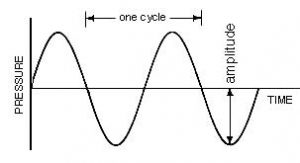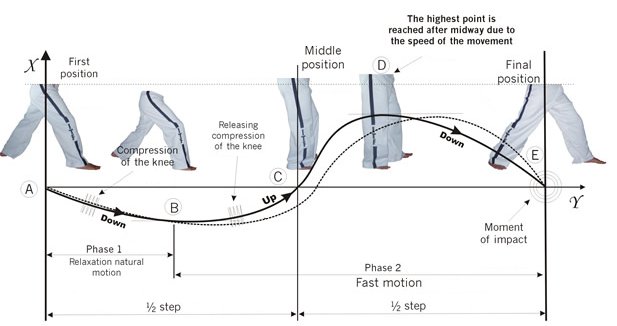What is Sine Wave?
Sine Wave refers to a mathematical graph often used when describing acoustics or simple harmonics.
A Sine Wave (or sinusoidal wave) is one that moves in a simple harmonic motion, where the oscillation is regular.
The diagram below demonstrates 2 cycles of a Sine Wave.

What does the application look like? Something like this:

Sine Wave is described as the "down-up-down" motion, however there is a caveat. Here are examples of stepping from one stance to another:
What sine wave really is, is using gravity to assist in amplifying speed and weight. The mass of the person will remain constant but when moving in a downward motion, the weight can change slightly with speed and gravity. The second piece is utilizing the mass to full potential, meaning for a brief moment, one should be completely off balance. Think of the act of walking. You take a step and the moment before your foot hits the ground you are falling, off balance, completely committed to the movement and unable to recover until the moment the stepping foot touches the ground. Commitment to the techniques should be performed in the same way as taking a step, literally throwing everything into the movement and not recovering until the finishing position, where everything lands at the same time and balance is regained.
So if we think of our normal daily walking movements, we have a naturally occurring sine wave, although it is more like up-down. So why down-up-down? Well the initial "down" isn't really down at all - it just feels that way. The correct way to perform the technique would be to think of having a book on your head, and keeping the book level until you reach the mid-point of the movement, where you stand up and then fall as you would taking a normal step. But since our patterns begin in lower stances, one must bend their knees quite a bit to simply remain in a level position as one moves forward. The degree to which you bend the legs will be entirely dependent on what the previous stance was. For example, if you are in a low stance, your initial "down" or bending motion will be more exaggerated as you attempt to remain level towards midpoint, than if you were in a rear-foot stance where your standing much taller.
With limited exceptions, Sine Wave should not look like bouncing while stepping. Most students tend to over-exaggerate the movement while trying to get comfortable with it. While performing on the spot techniques, it is sometimes necessary to create the full down-up-down motion in order to properly "fall" into the technique, but the initial "down" is more like a primer to the up position rather than a full squat or lunge, and in some circumstances there is no initial downward movement at all.
These are the types of motions and examples: (mvmnts-sw-breath)
- Normal motion (1-1-1) - one full Sine Wave is completed during each breath. This is the normal method of movement and is assumed in patterns and exercises unless another is specified.
- Continuous motion (2-2-1) - two Sine Waves during one breath, as part of two consecutive movements. This is seen in the low block/rising block movements in Dan-Gun for example.
- Fast motion (2-2-2) - two movements are performed consecutively in fast speed, with two Sine Wave and two breaths. This is seen in the double punch in Do-San for example
- Connecting motion (2-1-1) - two movements are performed in one Sine Wave and one breath. An example of this is the hooking palm block/punch movements in Yul-Gok.
- Slow motion (1-1-1) - the movement is performed slowly, but according to the theory of power there has to be a slight acceleration at the end of the movement. There is one (slow) movement, one Sine Wave, in one breath. Slow motion techniques are meant to teach the student body control and balance. This is seen for example in the angle punch in Joong-Gun.




